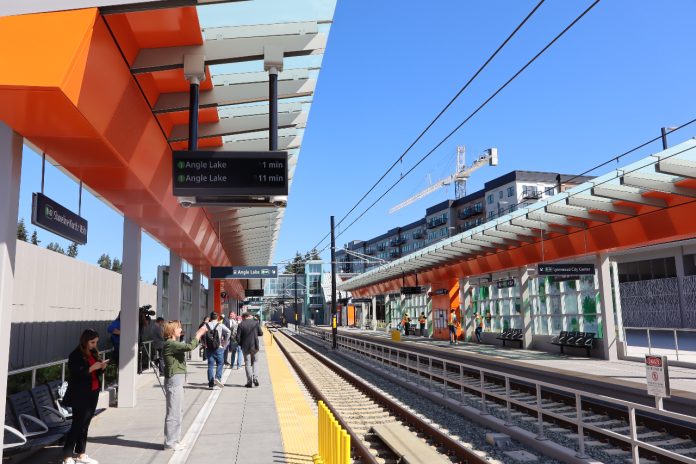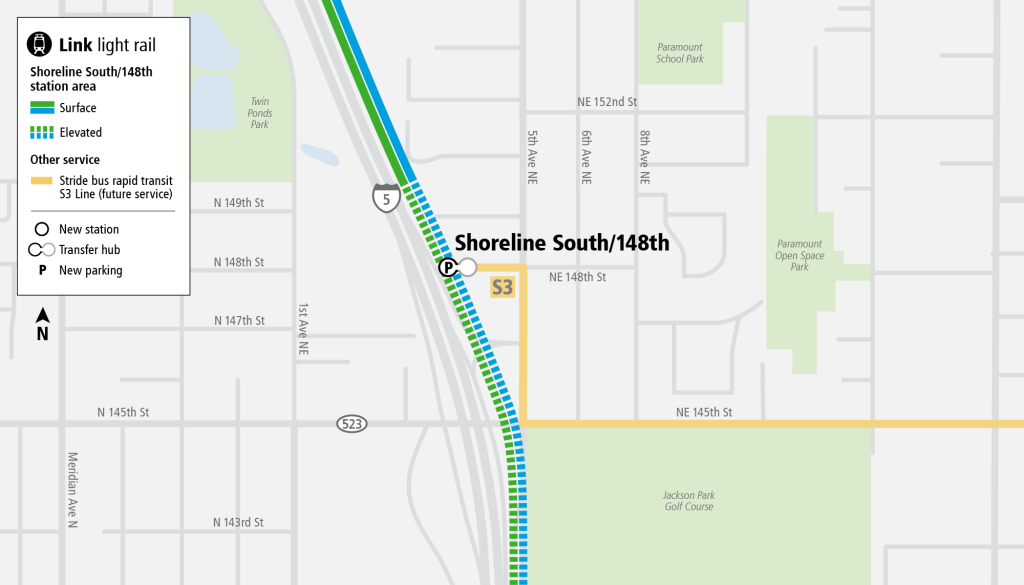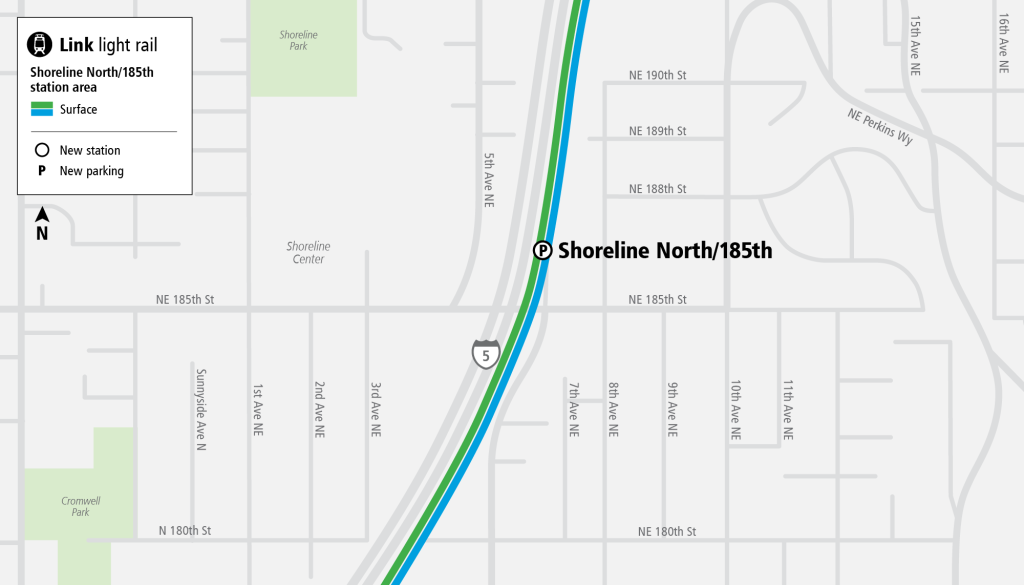The day has finally come for Sound Transit’s Link light rail system to extend into Snohomish County, with four new stations opening today as part of the Lynnwood Link extension project. Trains will start running north of Northgate today around 12:30pm, following speeches by elected officials and other dignitaries that begin at 11am at Lynnwood City Center station.
If speeches wrap early — always long odds on an event like this — trains will start earlier.
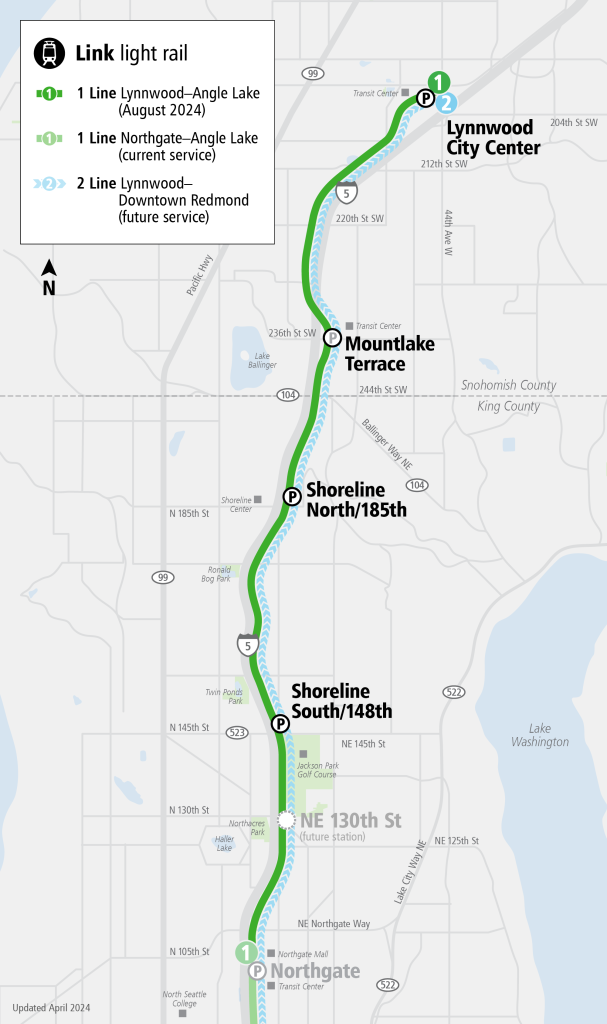
Responding to the transit traffic jams that plagued the East Link opening in April, Sound Transit has spaced out festivities for the the remainder of the day, with a gap of a few hours after the ribbon-cutting. At 4pm, events will take place at all four stations along the route, with a night market at Lynnwood City Center the main event.

The Urbanist is hosting a social hour at Hemlock State Brewing in Mountlake Terrace from 6pm to 8pm. We encourage you to stop by and say hi on your opening day travels. Mountlake Terrace will also be hosting a night market near the station with live music, interactive kid zone, food and drinks, and prizes and giveaways, as advertised in the snazzy poster below, which appears a nod to Works Progress Administration art of yore. And don’t forget the opening day events at the two Shoreline stations either.
Seattle is officially extending its light rail 8.5 miles north to Lynnwood today, IMO the most important US transit expansion of the year, and the graphic designers for the grand opening celebration cooked up this absolute masterpiece pic.twitter.com/BPjzMyClKy
— Joey Politano 🏳️🌈 (@JosephPolitano) August 30, 2024
As The Urbanist has recapped this month, light rail is causing quite the transformation along the 8.5-mile extension, with roughly 10,000 homes added recently or in development near the four stations. Cities are also preparing infrastructure upgrades to serve their stations to accompany the new housing and anticipated riders — see our piece on those long-range planning and infrastructure efforts.
Sound Transit projects the Lynnwood Link extension is expected to add 50,000 daily riders to Sound Transit’s light rail network, which had been averaging upwards of 90,000 daily riders before the expansion.
Lynnwood Link traces the path of I-5, with the first three stations on the east side of the freeway, and Lynnwood City Center on the western side. As urbanists are wont to tell you, freeway proximity comes with significant downsides, from the air and noise pollution to the fractured walkshed, making it harder to walk, roll, or bike to the station. A freeway bisecting the station area will make it harder to grow a thriving urban neighborhood, but the cities along the line have taken some steps to mitigate the challenges and are making some strides nonetheless. The high quality bus feeder networks local transit agencies have added at each station should spread the benefits of light rail across a wider area.
Shoreline South/148th Street
Shoreline South has seen one of the largest transit-oriented development (TOD) booms of any of the stations, transforming an area formely composed of single family homes into apartment blocks. Overall, builders have planned or constructed 3,087 homes around the South Shoreline Station since 2021, as we detailed in our development roundup.
So far, most of Shoreline South’s construction activity has been on the west side of the station — a longer walk away across the I-5 chasm. The west side of I-5 has hosted 450 of the 485 completed housing units and 791 of the 803 under-construction units. That’s 1,241 homes built or under construction compared to just 47 on the east side of I-5. However, the next round in the pipeline is more weighted toward the east side closer to the station.
To serve the growing population to the west, Shoreline has a pedestrian bridge in the works to span I-5 at 148th Street, providing a more direct and pleasant way to cross I-5 avoiding the detour to busy 145th Street three blocks south. Backers are hoping to open the ped bridge in 2026.
As it stands, the Shoreline South neighborhood is still a work in progress, with the business districts focused on Aurora Avenue and 15th Avenue NE, more than a 15-minute walk from the station. However, that’s likely to change as new businesses go on the first-floor of new complexes and the urban area fuses together, aided by improved Shoreline bus connections inbound with the fall service change on September 14. Route 333 will be an important circulator for those looking to head west along N 145th Street
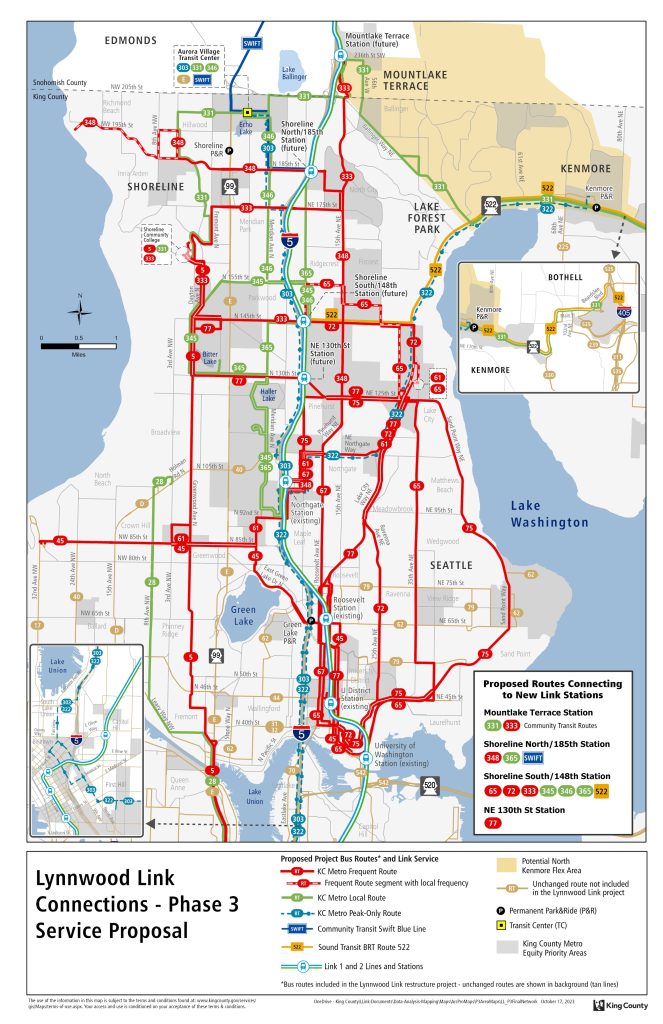
Led by the boom by its south light rail station, Shoreline has added more housing than any other city in Washington on a per-capita basis over the past five years, outpacing both Seattle and Redmond. And the city isn’t showing any signs of hitting the brakes anytime soon.
Shoreline North/185th
Shoreline North is a bit of a different story. Less housing is in the pipeline near the station at about 1,700 homes, but there are fast growing areas a bit father afield along Aurora Avenue and in North City. In our Shoreline North development roundup, we predicted that development around the station will eventually create a new dense linkage between the two urban sections in North City and along Aurora.
Similar to Shoreline South, the main business districts are not in the immediate vicinity of the station, but rather along Aurora Avenue to the west or near 15th Avenue NE to the east. Mixed-use development and a few smaller business nodes have added some modest commercial activity closer to the station, but it will take more development to fill in the gaps and create a continuous urban district from Aurora to North City.
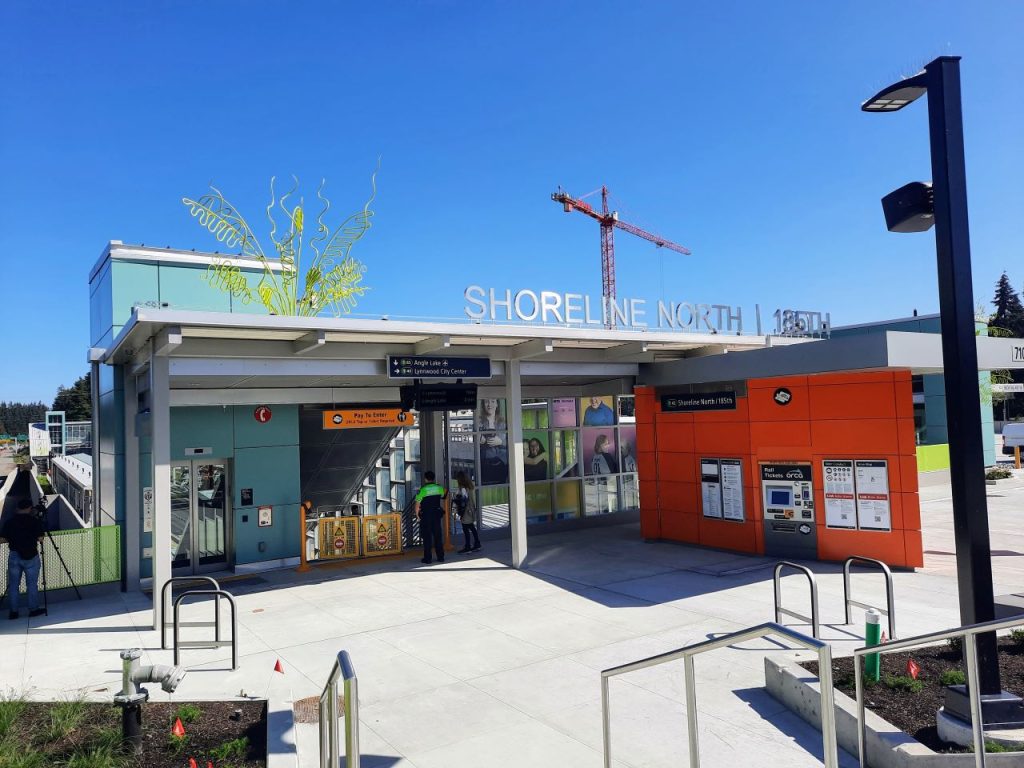
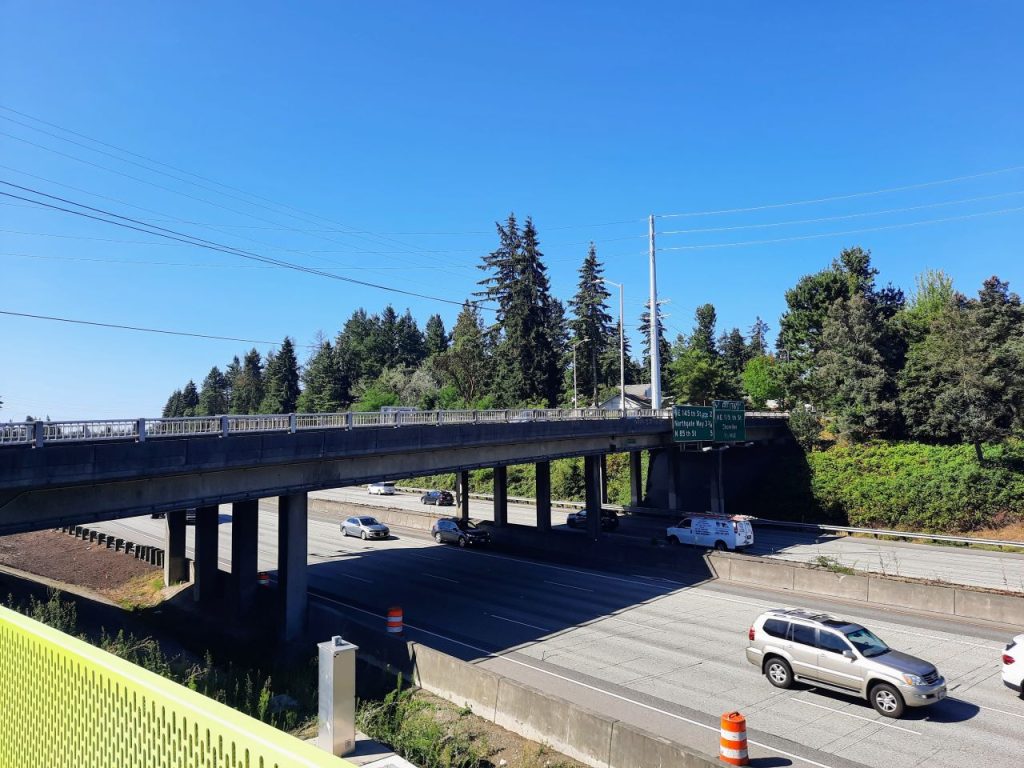
On the other hand, Shoreline North does take the cake for the TOD project closest to the station, with the 240-unit Kinect @ Shoreline looming over the station platform and abutting the parking structure.
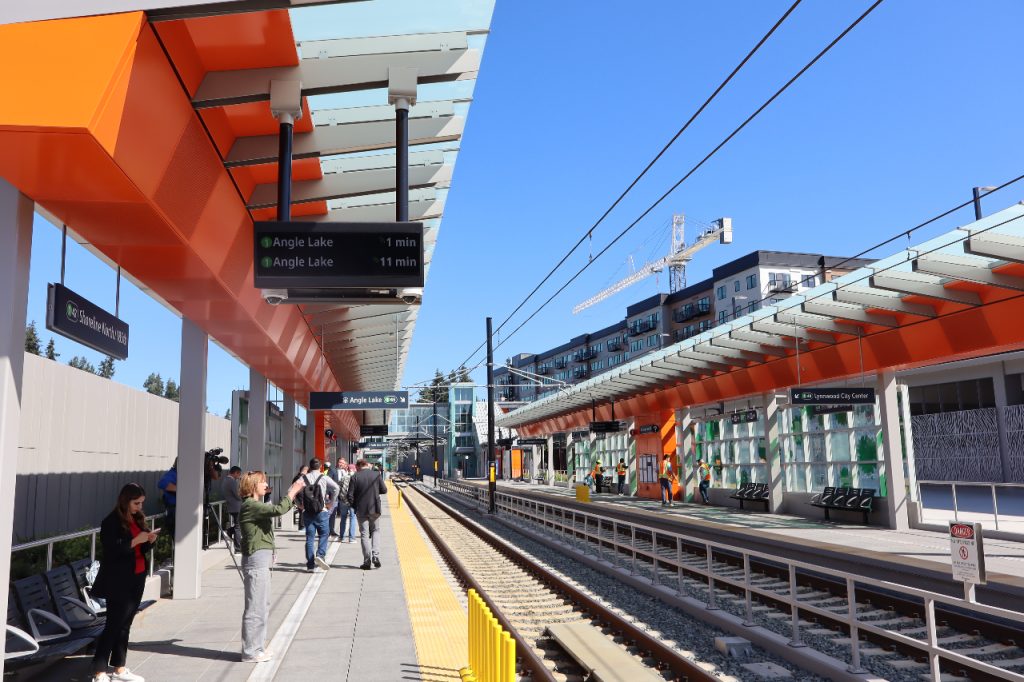
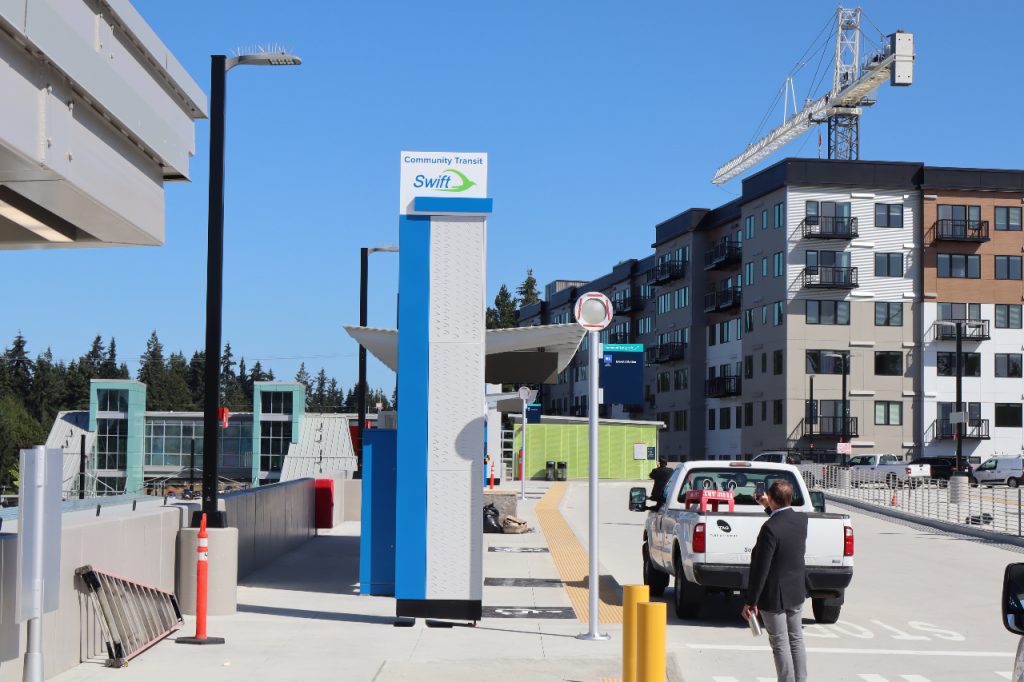
Shoreline North’s station art includes a nod to science fiction writer Octavia Butler (who lived nearby in Lake Forest Park) in the fold of green blobs adorning the otherwise orange station platform, creating an alien landscape.
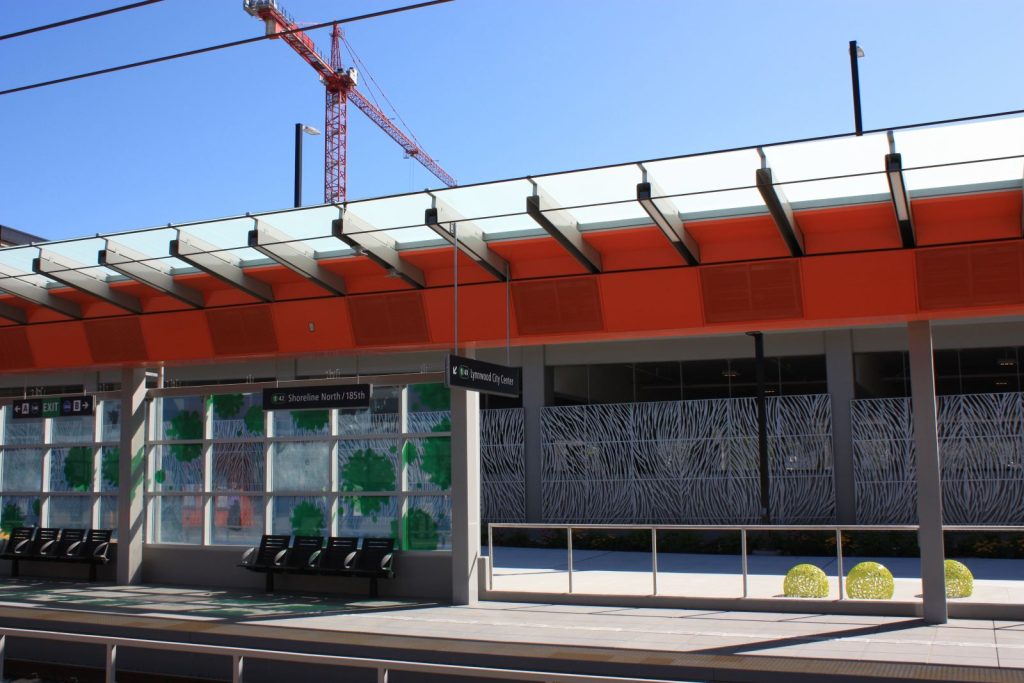
Mountlake Terrace
Mountlake Terrace is the first station in Snohomish County, and the station area has been the heart of the city’s plans to densify. As we broke down in our Mountlake Terrace development roundup, more than 1,800 homes are in the works near the station. All of these are on the east side of I-5. The publicly owned Nile Shrine Golf Course and single family zoning consumes the walkshed to the west.
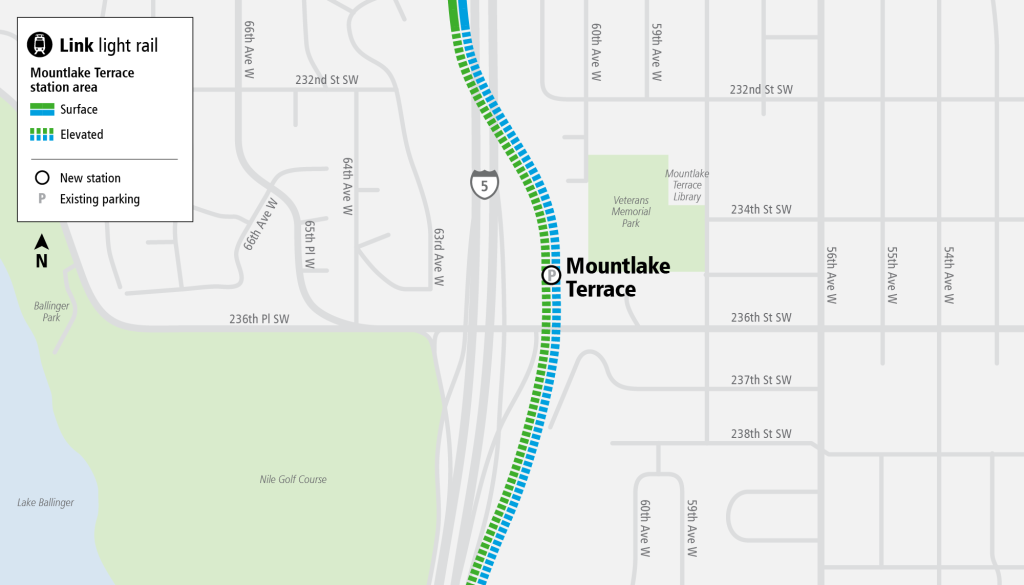
On the east side, Mountlake Terrace has allowed buildings to reach 12 stories in height near the station, though no builders have taken them up on that yet. Several eight-story apartment buildings are on the way, however.
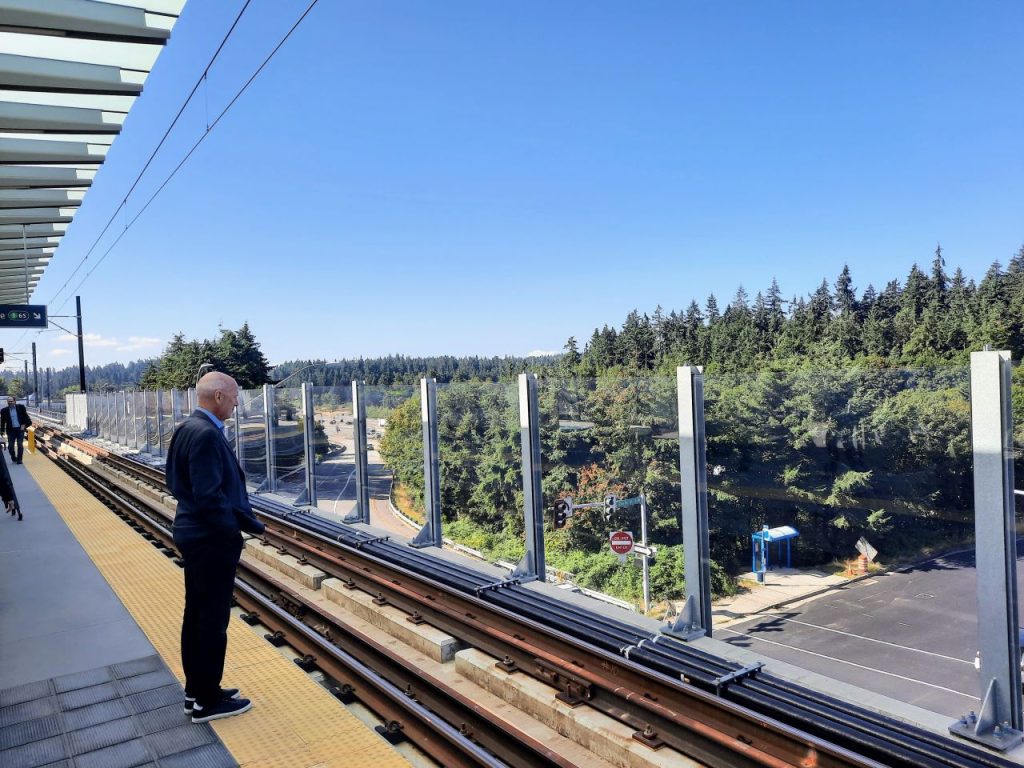
Lynnwood City Center
The last station opening as part of Lynnwood Link is, of course, Lynnwood. As Link’s northern terminus for the next 13 years or so, this station has received a ton of attention. We wrote up a station tour earlier this week, providing an overview of features, including a transit center where more than half of the buses in Community Transit’s fleet will pass through offering connections to Mukilteo, Edmonds, Lake Stevens, and beyond. There’s also a five-story, 1,670-stall parking garage adjoining the station.
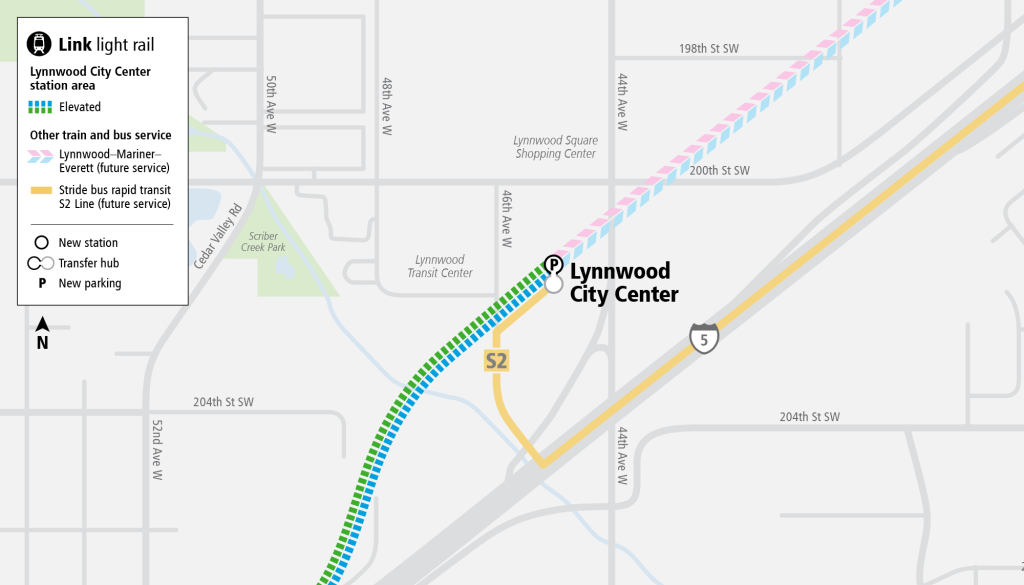
Planning efforts have been ongoing for a long time to grow a “city center” near the station, disrupting the mall-oriented and suburban bedroom community pattern of development that had long characterized Lynnwood. Lynnwood Mayor Christine Frizzell cited the 1993 Legacy Lynnwood Project, a copy of which she keeps on her desk as the first iteration of the rail-oriented city center concept, with major community buy-in at the time.
That long planning effort doesn’t mean you’ll step off the train and see a dense city center before your eyes. Some of the projects have been slowing in coming together, facing the major headwinds of high interest rates and construction inflation. However, once the affordable TOD project on the surplus Sound Transit site is finished, there will at least being an apartment anchor in the sea of parking, gas stations, strip malls, and a few low-slung apartments that greet riders today.
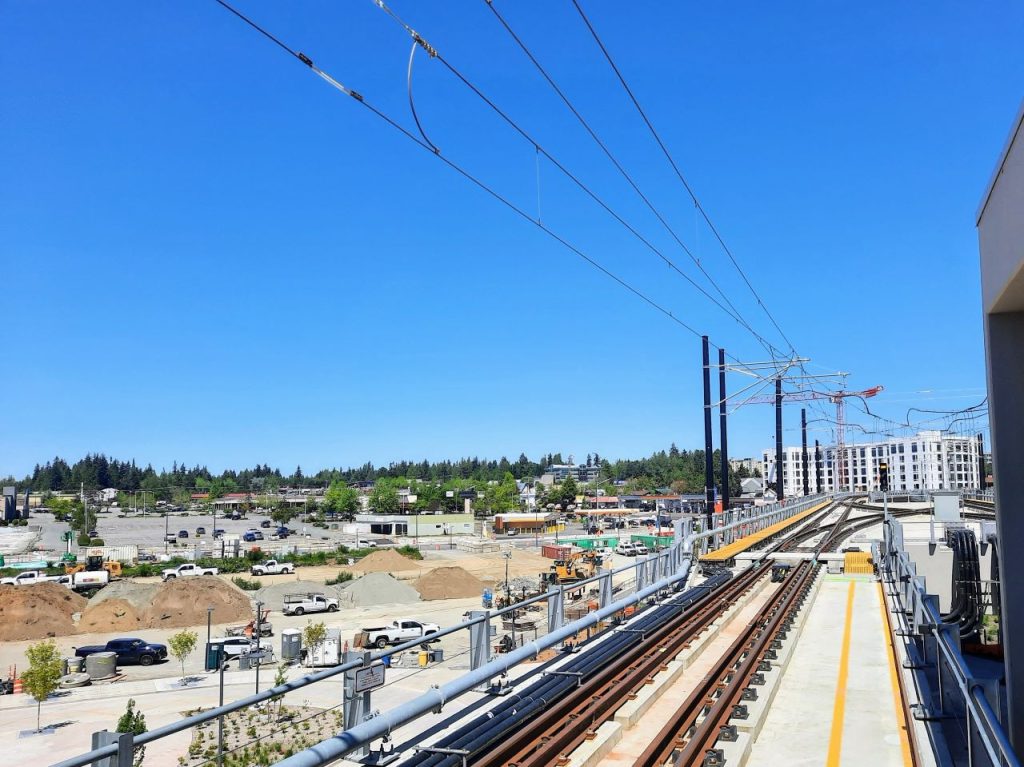
The massive Northline Village project could deliver nearly 1,400 homes across the streets at the mostly dead strip mall once it gets underway. For now, developer Merlone Geier Partners is waiting out more favorable market conditions to strike on its 19-acre site.
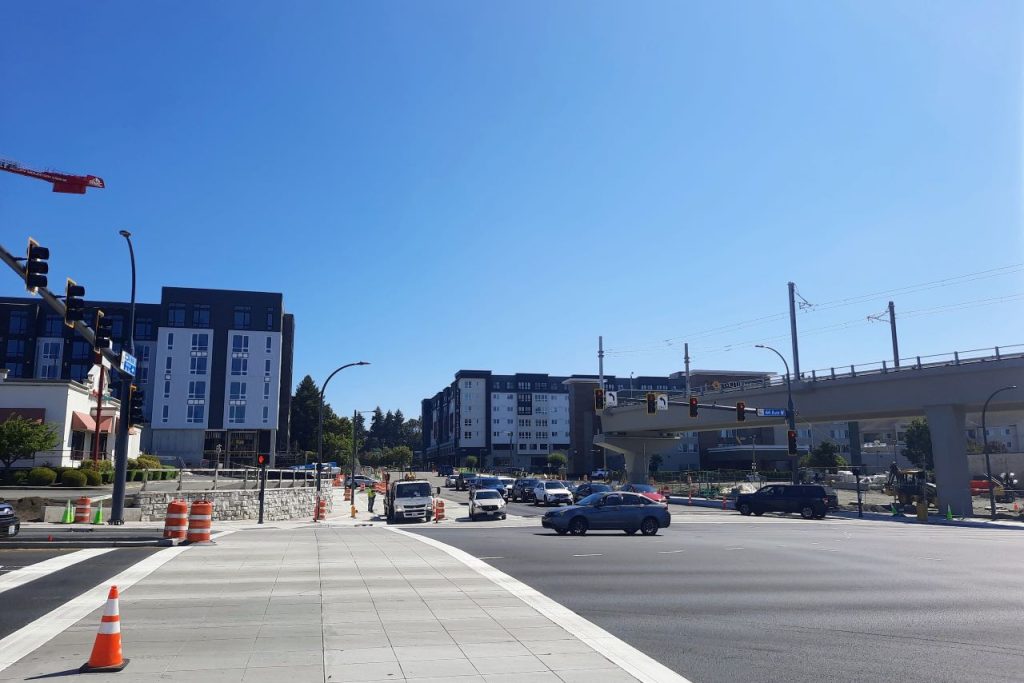
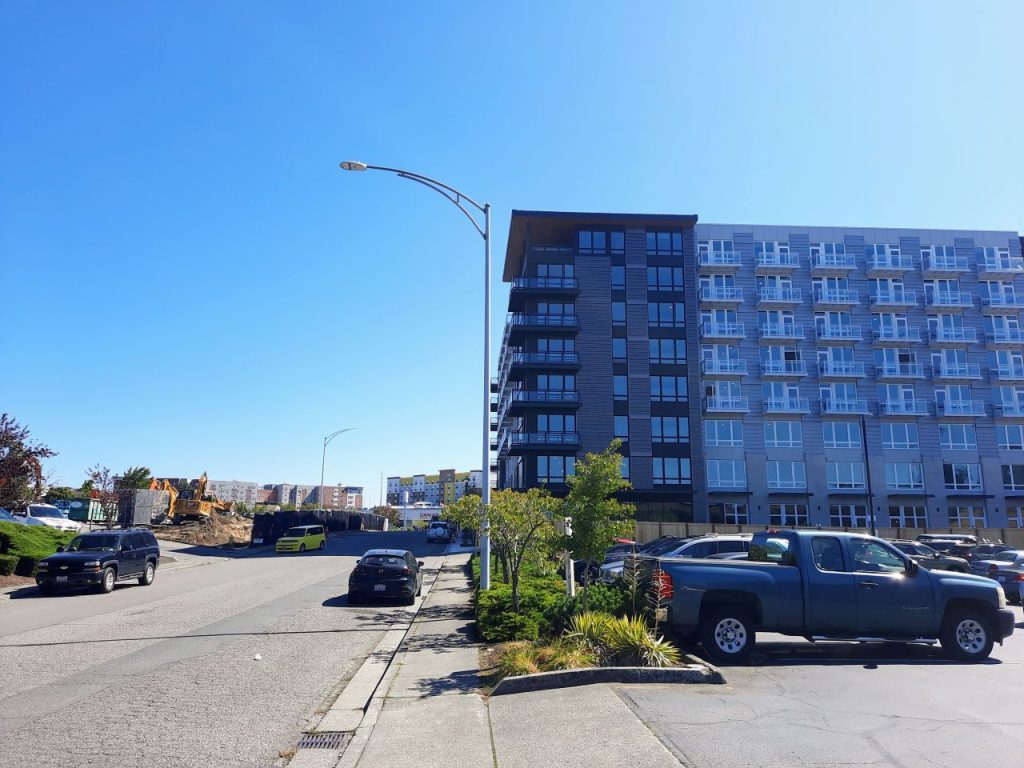
Farther from the station, transit oriented development is happening. Including another Kinect project and Ember Apartments. But it largely still feels like a series of strip malls and office parks poorly connected by oversized suburban collector streets and circuitous mall parking alleys. Since interest rate and inflation headwinds aren’t likely to last for long, it seems likes development activity will pick up in Lynnwood City Center and the area will fill in, fulfilling the dreams and visioning exercises of the last 30 years.
What About 130th Street?
Riders heading past Northgate may notice a blank spot on the map before Shoreline or a gap in the station numbers. North Seattle’s last light rail station at NE 130th Street is under construction, but isn’t set to open until 2026. Included in the 2016 Sound Transit 3 ballot measure, the station was originally scheduled to be delivered in 2031, but efforts by Sound Transit board members, primarily former Seattle Councilmember Debora Juarez, accelerated the timeline. But an initial 2025 timeline did ultimately slip to 2026.
That doesn’t mean Seattle has accelerated its timeline for adding density around the station, with the draft Seattle Comprehensive Plan proposing moderately denser zoning near the station, though that still must be finalized approved by the Seattle City Council.
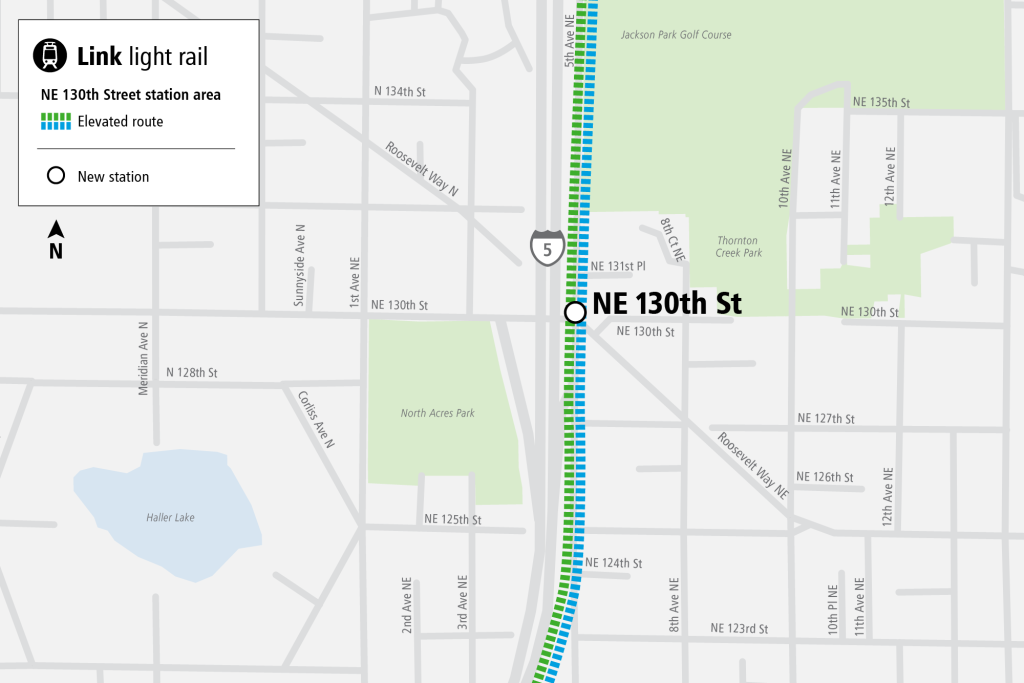
What’s Next After Lynnwood?
The 1 Line will extend north to Everett from today’s terminus at Lynnwood City Center in 2037, at least according to current Sound Transit plans. As part of that six-station extension, Lynnwood will get a second station dubbed “West Alderwood” at the edge of the Alderwood Mall. Unincorporated Snohomish County is also getting some love with stations at the park and rides at Ash Way and at Mariner. Everett will get the next three stations, including a station near Paine Field and Boeing’s Everett Production Facility via a circuitous dogleg away from the I-5 corridor the line otherwise tracks.
Current Everett Link plans require heavy property takings along the wide highways it tracks so as to avoid taking highway lanes or disrupting traffic. This could push project costs upward and increase displacement of businesses and homes. However, Snohomish County and Sound Transit appear committed to this path. The hope is the Paine Field grows into a major secondary airport to complement Sea-Tac, and that Boeing workers, who largely drive today, switch to transit in significant numbers and still have jobs in Everett rather than being off-shored.

